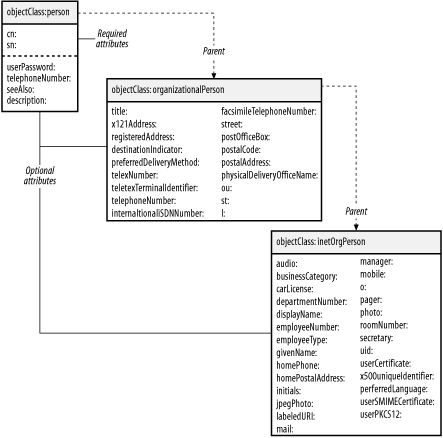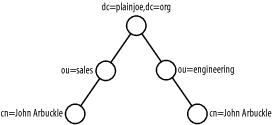Defining the Schema
The first step in implementing a directory is determining what information to store in the directory. The naming context of your server has already been defined as:
dc=plainjoe,dc=org
Store contact information for
employees in the people organizational unit:
ou=people,dc=plainjoe,dc=org
There are several ways to identify the data that should be placed in an employee’s entry. Information stored in an existing Human Resources database can provide a good starting point. Of course, you may not want to place all of this information in your directory. As a general rule, I prefer not to put information in a directory if that data probably won’t be used. If it turns out that the data is actually necessary, you can always add it later. Eliminating unnecessary data at the start means that there’s less to worry about when you start thinking about protecting the directory against unauthorized access.
An alternative to starting with an existing database is to determine which employee attributes you wish to make available and define a schema to match that list. The reverse also works: you can select a standard schema and use the attributes already defined. I prefer this approach because it makes it easy to change from one server vendor to another. Widely used, standard schemas are more likely to be supported by a wide range of vendors. Custom, in-house schemas may need to be redesigned to adapt to a new vendor (or even a new version from the same vendor).
For your directory, the inetOrgPerson schema
defined in RFC 2798 is more than adequate. From
Section 3.5.1 in
Chapter 3, we know that this object class and
associated attributes are defined in OpenLDAP’s
inetorgperson.schema
file. As shown in Figure 4-1, an inetOrgPerson is a
descendant of the
organizationalPerson
, which was itself derived from the
person
object class.
The union of these object classes defines the set of required and
optional attributes that are available. This means that the only
required attributes in an inetOrgPerson object are
the cn and sn attributes
derived from the person object class.
Tip
From this point on, diagrams of an object class will not include RFC 2252-style schema definitions. If you wish to study the exact syntax of any object class, refer to the schema files included with OpenLDAP or the relevant RFC (or Internet-Draft).
Your directory will use the
cn
attribute as the RDN for each entry.
Remember that the RDN of an entry must be unique among siblings of a
common parent. In larger organizations, two people may have the same
first and last name. In these cases, using a more specific value for
the cn, such as including a middle name (or
initial), can alleviate name collisions.
Another way to reduce the number of name collisions is to redesign the directory layout to reduce the total number of user entries sharing a common parent. In other words, group employees in some type of logical container, such as a departmental organizational unit. Figure 4-2 illustrates how this design avoids namespace conflicts. In this directory the “John Arbuckle” in sales is different from the “John Arbuckle” in engineering because the entries possess different parent nodes.
For our example, going with a single container of
ou=people is fine; furthermore, our employee base
is small enough to use an employee’s common name
(cn) without fear of conflict. Figure 4-3 shows the directory namespace developed so
far.
Here is an employee entry that contains the attributes needed for our
directory. Notice that the two required attributes outlined in Figure 4-1, cn and
sn, are present in addition to several optional
attributes.
## LDIF entry for employee "Gerald W. Carter" dn: cn=Gerald W. Carter,ou=people,dc=plainjoe,dc=org objectClass: inetOrgPerson cn: Gerald W. Carter sn: Carter mail: jerry@plainjoe.org mail: gcarter@valinux.com labeledURI: http://www.plainjoe.org/ roomNumber: 1234 Dudley Hall departmentNumber: Engineering telephoneNumber: 222-555-2345 pager: 222-555-6789 mobile: 222-555-1011
Get LDAP System Administration now with the O’Reilly learning platform.
O’Reilly members experience books, live events, courses curated by job role, and more from O’Reilly and nearly 200 top publishers.




